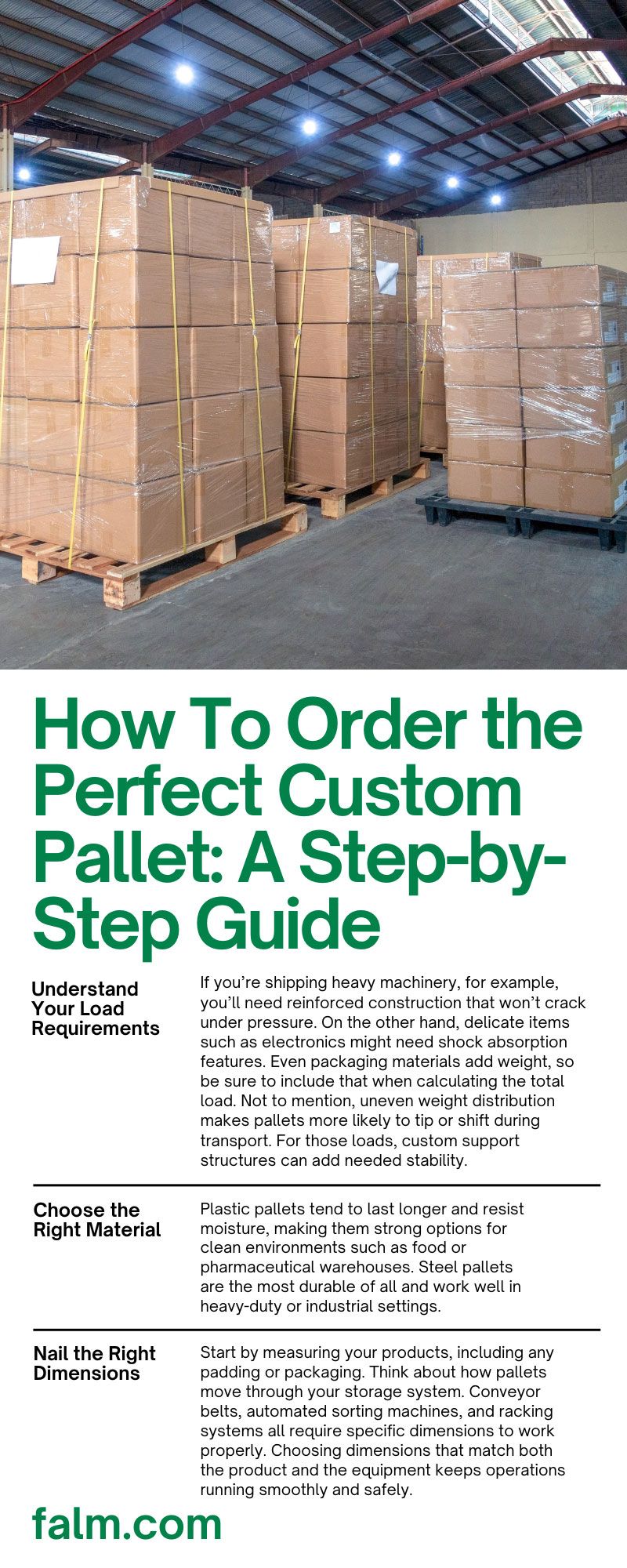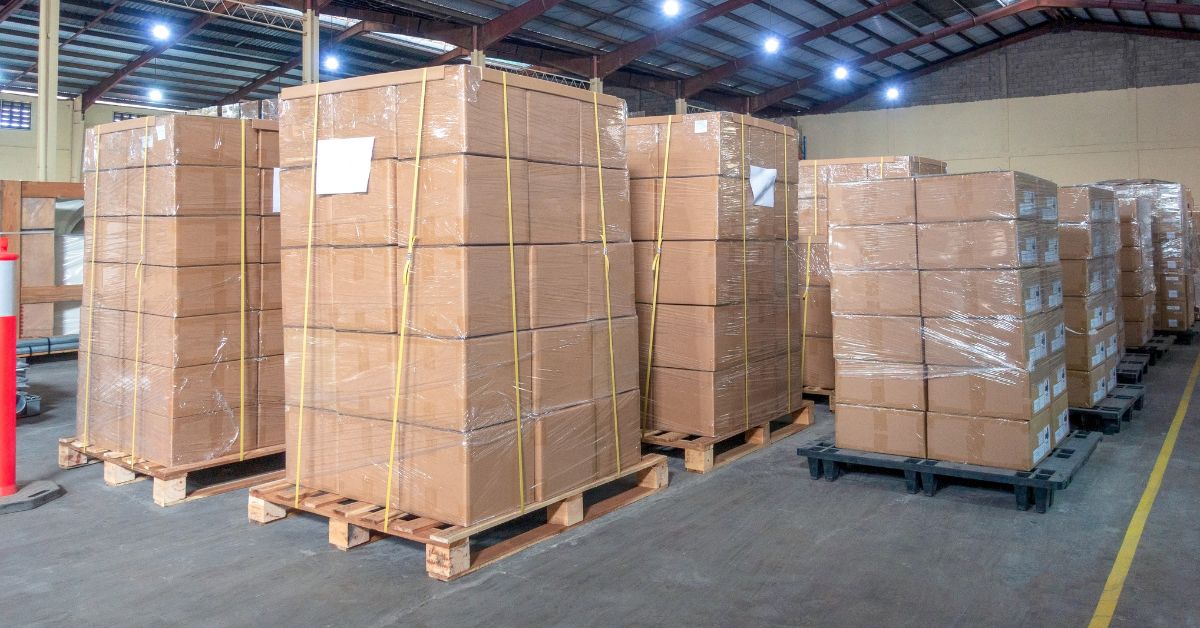- By First Alliance Logistics Management
- October 22, 2025
- Buying Pallets
Ordering custom pallets can turn chaotic shipping into a smooth, reliable process. The right pallet design keeps products protected, reduces damage during transport, and helps your warehouse run more efficiently.
Whether you’re shipping electronics, food products, or heavy machinery, knowing how to order the perfect custom pallet gives your business an edge. This step-by-step guide details everything you must consider, from load requirements to supplier selection, so you can make smart, cost-effective choices.
Understand Your Load Requirements
First, look closely at your product. Each item has unique characteristics that affect the type of pallet it needs. Factors including weight, shape, handling needs, and weight distribution determine a successful pallet design.
If you’re shipping heavy machinery, for example, you’ll need reinforced construction that won’t crack under pressure. On the other hand, delicate items such as electronics might need shock absorption features. Even packaging materials add weight, so be sure to include that when calculating the total load. Not to mention, uneven weight distribution makes pallets more likely to tip or shift during transport. For those loads, custom support structures can add needed stability.
Choose the Right Material
Material choice has a big impact on cost, durability, and how well a pallet performs in your specific environment. Wood is the most common option, offering a solid mix of strength and affordability. It works well for general-purpose shipping and is easy to repair.
Plastic pallets tend to last longer and resist moisture, making them strong options for clean environments such as food or pharmaceutical warehouses. Steel pallets are the most durable of all and work well in heavy-duty or industrial settings.
In some industries, compliance also plays a role. For example, pallets used for international shipping must meet ISPM-15 regulations, which require heat treatment or fumigation. It’s important to factor in these standards early in the process.
Nail the Right Dimensions
Accurate pallet dimensions go a long way in improving efficiency and reducing costs. Custom sizes may seem like a hassle at first, but they can significantly increase how much product you can fit on a truck or inside a warehouse.
Start by measuring your products, including any padding or packaging. Think about how pallets move through your storage system. Conveyor belts, automated sorting machines, and racking systems all require specific dimensions to work properly. Choosing dimensions that match both the product and the equipment keeps operations running smoothly and safely.
Match the Weight Capacity
Not all pallets can handle the same load. If you exceed a pallet’s capacity, you risk damaged products and safety hazards. There are two types of loads to think about: static (when pallets are at rest) and dynamic (when they’re being moved).
Handling equipment, such as forklifts and pallet jacks, also adds pressure, especially when they lift or drop loads. That’s why most businesses add a 25 to 30 percent buffer above the maximum weight to account for impact and movement. Choosing the right load capacity reduces the chance of structural failure and supports safer working conditions across your operations.
Consider the Storage Environment
The conditions where your store or transport pallets affect material performance. Temperature swings, humidity, and chemical exposure can wear down some materials faster than others.
Wood pallets, for example, absorb moisture, which can lead to warping or mold. Plastic or metal options tend to perform better in high-humidity environments. Cold storage can make some materials become brittle, so choose pallets that maintain strength in these conditions.
Industries such as food processing and pharmaceuticals often require bacteria-resistant pallets that are easy to clean. Materials matter more than you think, especially when dealing with strict safety or hygiene standards.
Keep Equipment Compatibility in Mind
One of the most overlooked parts of pallet planning is compatibility with the equipment used to move and store them. A pallet that doesn’t fit properly with your forklifts, conveyors, or automated systems can create delays, damage, or safety concerns.
Standard forklifts rely on certain entry points for lifting. Automated systems, including robotic warehouse operations, often require precise dimensions and features such as smooth surfaces or reinforced edges. Even conveyor systems have specific spacing needs. Designing your pallet with equipment in mind avoids costly adjustments and keeps logistics flowing.
Think About How Products Ship
Pallets must also be transported easily. Products moved by truck face different conditions than those shipped by rail or ocean freight. Vibration, stacking, and exposure all vary.
If you’re shipping internationally, factor in border regulations. Many countries require new wood pallets to be heat-treated or fumigated to prevent pest transfer. These treatments must meet the ISPM-15 standard, and using the wrong pallet type can result in delays or rejected shipments.
Evaluate Costs the Smart Way
It’s easy to focus on upfront costs, but long-term value matters more. A cheaper pallet might save money today, but if it breaks easily or needs frequent replacement, it could end up costing more down the line.
Stronger materials or custom designs might cost more at first, but they often hold up better, reducing replacement frequency and lowering repair costs. Buying in volume can also unlock better rates, especially if you place regular orders or partner with other departments to increase quantity. Think of your pallet as part of a larger supply chain investment, not just a one-time purchase.
Work With a Supplier That Knows the Ropes
Choosing the right pallet supplier can make the entire process easier. A good supplier will ask the right questions, suggest improvements, and offer practical solutions based on experience.
Look for suppliers that offer engineering support, including design feedback and CAD drawings. In addition, check that they provide load testing or prototyping to confirm your design performs well. Suppliers with experience in your industry can often spot problems before they happen. They also know how to meet unique needs, for example, sourcing new wood pallets for global shipments or adapting pallet builds for automation.
Test Before You Go All In
Before placing a large order, run tests under real-world conditions. Prototype testing shows how a pallet handles the actual weight and movement of your products. Drop testing can reveal whether it protects your goods during rough handling.
Field trials are especially useful. They let you see how pallets hold up over time in your specific warehouse or shipping environment. Testing increases confidence in your design and prevents costly redesigns or failures later.
Start Your Improved Logistics Journey Today
Now that you know how to order the perfect custom pallet, it’s time to apply what you’ve learned. Start by reviewing your product load, equipment, and shipping needs. Then, pick materials and dimensions that match your environment. Make sure to work with a knowledgeable supplier who can support you through the design and testing processes.
Ready to upgrade your logistics operations? First Alliance Logistics Management has years of experience creating custom pallet solutions that improve efficiency and reduce shipping costs. Whether you’re scaling up or you need new wood pallets for international trade, our team is ready to guide you through the process. Contact us today to build a smarter supply chain from the ground up.


